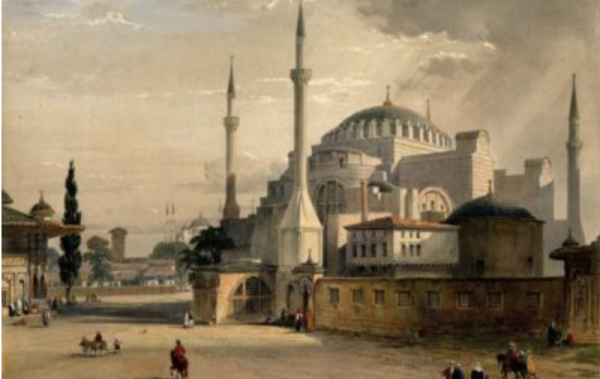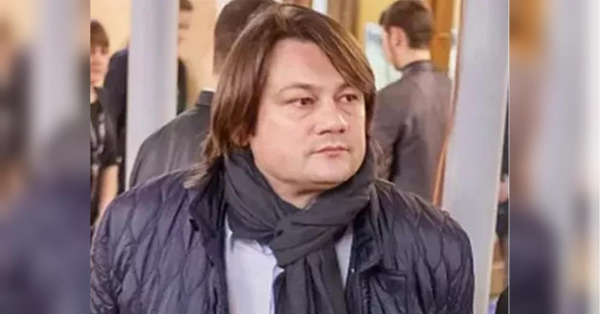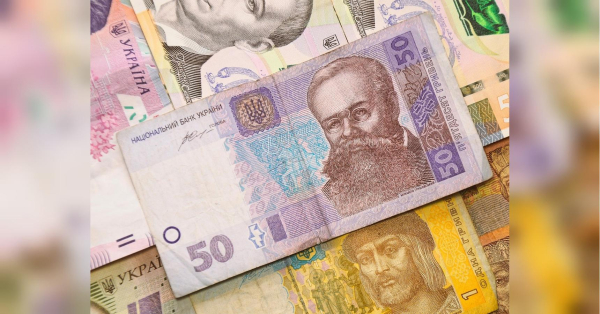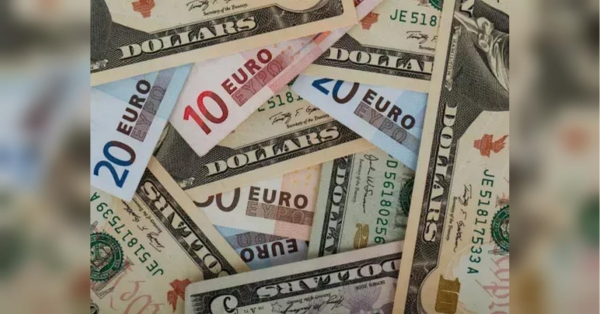
In A.D. 1475 the Principality of Theodoro fell to an Ottoman siege. The final rump state of a rump state of what had once been the Eastern Roman Empire, Theodoro’s fall had been inevitable since the capture of Constantinople by the Ottomans in 1453, the date historians usually point to as the fall of Eastern Rome. But whether one pegs the final end of the Eastern Roman Empire to 1453 or 1475 is beside the point; the fall of the empire, sometimes referred to as the Second Rome, was a seismic event, ending over two millennia of some form of Roman statehood. But the full reverberations of that fall took centuries to become clear, and certainly never were so to those living at the time.
Though it may not seem so at first, the world finds itself in a similar situation today in regard to what was once called the “Third Rome”: Moscow, the heart of the Russian Empire, Soviet Union, and the current-day Russian Federation. Moscow received this moniker due to its proximity to the Second Rome, Constantinople, its close relationship to that empire, and their shared Orthodox Christianity. And the fall of that Second Rome provides a roadmap of warning to Western policymakers today regarding the final fall of the Third.
Advertisement
Of course, most foreign policy analysts, especially those of the liberal internationalist variety, would not see a connection here beyond historical happenstance. To them, the Third Rome, such as it was, ended when the Russian Empire fell in 1917. Most Western analysts and policymakers view the current state of affairs in Eastern Europe as nothing more than post-Soviet Russia making a last-gasp attempt at retrieving its former territories in order to climb back to its 1950s communist heights, a time in which it was the clear ruler of Eurasia. This explains President Joe Biden’s administration’s recent call for a “weakened Russia” and Biden’s improvised call for regime change. In his eyes, the current Russian Federation is simply the weak and dying Soviet Union, led by weak and dying former communist officials. Those crafty cartoon communists, Boris and Natasha, are at it again, and those on the right side of history must step in.
But there is another possibility, one which should be taken seriously by those who seek to determine the future of the world: that we are not in the aftermath of the Soviet Union but are instead still in the final days of the Third Rome. The idea of the Russian Empire still existing in spirit is not original; for just one example, it was recently espoused by the Russian author, philosopher, and historian Boris Akunin. But it has flown under the radar of major Western policymakers on all sides of the political spectrum and it deserves attention, because when viewed through this lens recent historical events take on a different hue.
In this telling, the Soviet Union was a last-ditch attempt by a group of radicals, knowingly or unknowingly, to resurrect Russian imperial greatness. The war in Ukraine, therefore, is the twilight struggle not of a dictatorship which lasted half a century, but of an empire which lasted nearly five. This leads one to a conclusion opposite that of the former view: that the West should be cautious in seeking to destabilize or destroy the Russian Federation. Far from desiring to end the aftermath of a failed communist experiment, the West may inadvertently be seeking to finalize the half-millennium old Russian Empire.
We should therefore be wary of wantonly seeking to “weaken” Russia. This warning was most recently exhibited by former Secretary of State Henry Kissinger at Davos, who called on the Ukrainians to “match the heroism that they have shown in the war with wisdom for the balance in Europe and in the world at large.”
For inspiration as to how to proceed with balance and the West-Russian relationship, and for warning as to what not to do, we can look to the fate of Russia’s Orthodox progenitor, the Second Rome: the Eastern Roman Empire, its collapse, its final stand, and all that followed.
Advertisement
By A.D. 1000, the Eastern Roman Empire was nearly 700 years old, having emerged from a final late-300s split of the original Roman Empire into two halves. It far outlived its Western brother, which disappeared in A.D. 476, the date usually pegged as the “fall of Rome.” From then on Eastern Rome, centered on Constantinople, carried the Roman torch. Sometimes the flame burned hot, such as under the Emperor Justinian the Great when the empire expanded west as far as Spain. But sometimes the flame cooled, and by the late 11th century it had cooled dangerously. A series of internal revolts and external conflicts had brought the empire to its knees, and collapse seemed imminent.
Collapse, however, was staved off when a new government took the throne: the Komnenos dynasty. Through starts and fits, under Emperor Alexios I Komnenos and his successors, the empire dramatically expanded its borders and once again became a major power. But though the Komnenian variant of the Roman torch burned brighter than many of its predecessors, it burned out quickly. By 1204 the empire had once again shrunk and was even briefly conquered by the West, its government replaced with a Catholic government of mostly French emperors and propped up by Venice, which desired more control over trade routes. This small state, now called the Latin Empire, itself lasted only until 1261 whereupon it was supplanted by a re-established Byzantine Empire when Constantinople was re-captured by the Byzantine Palaiologos dynasty.
The re-established empire was far from its earlier heights and further still from the heights of the original Roman Empire. After a short period of under 200 years, Constantinople fell finally to the Ottoman Empire in 1453. Just over 20 years later, its last remnant, the aforementioned Principality of Theodoro, went with it. The last of the Second Rome was no more.
Looking at the path of the Second Rome, one can detect a striking similarity to that of the Third. Like its Orthodox predecessor, Russia has had a long and storied history, full of different states and types of government: some religious in nature, some less so. Like the Byzantines, Russia was sometimes ruled by natives and other times by those who had been born elsewhere. But if viewed as one long imperial history, the similarities become even more acute.
Told this way, the Soviet Union was not a new state, but was instead the Russian equivalent of the Komnenian restoration: a new governing force taking control after a civil war and overseeing rapid expansion. For the Byzantines, that force was the strong-willed and clear-eyed Komnenian dynasty; for the Russians, it was the Bolsheviks who seized power over the state apparatus. Both of these new governing forces had slow starts and both arguably began their true ascent under their second “dynastic” leaders, Alexios I Komnenos for the Byzantines and Josef Stalin for the USSR. Within decades, both had massively expanded: the Byzantines unquestionably reattained great power status (or at least its early 1000s equivalent) in their part of the world, and by the 1950s the Soviet Union’s sphere of influence ran across Eurasia from Berlin to Beijing.
But just like the Komnenian restoration, the rapid Bolshevik expansion soon reversed. Just over 100 years after Alexios I Komnenos took the throne of the Second Rome and undertook his expansions, the Byzantines were, as discussed, briefly conquered by the Latin West in 1204. Likewise, the Bolshevik “imperial restoration” fell after just over six decades to Western ideological forces in the late 1980s and early 1990s. While the Third Rome was not literally conquered by the West as Constantinople was, Moscow for the period of the 1990s was run by the Boris Yeltsin administration, a government which itself was effectively run by Western neoliberal thought and was, in the case of the 1996 Russian presidential elections, literally kept in power by American electoral interference.
Finally, both the Second and Third Romes followed their periods of Western control or influence with the throwing away of that Western rule, the former by re-establishing the Byzantine Empire under the Palaiologos dynasty and the latter in the form of President Vladimir Putin. Like the Palaiologos did with their forebears, Putin’s government has brought back all of the symbols of former Third Roman greatness: love of country, Orthodoxy, pride in history, a distrust of the West, and respect for the leader while not necessarily creating a cult of personality—all while failing to truly stave off decline. Putin’s Russia is attempting to gain territories it once controlled and is desperately fighting to restore its former sphere of influence, as the Palaiologos’ Byzantium did. But like the Second Rome, the Third faces overwhelming headwinds: a rising East, nationalism in former colonial and territorial possessions, internal corruption, and a West intent on using trade and other means to weaken and grind it down.
Those troubles were ultimately enough to blow the Byzantines to the winds of time. Will they blow Russia away today? And what happens if they do? These are the questions the West must now face.
This is not intended to justify Russia’s actions by way of analogy or comparison. It is instead intended to draw attention to the critical importance of understanding that the events which are currently unfolding are the results of tensions that began far earlier than the end of the Soviet Union in 1991. Those tensions should not be waved away; “they’ve been fighting forever” is no reason to ignore the details. It is reason to pay even closer attention and to put aside phrases such as “right side of history” and open-ended policies like desiring a “weakened Russia.”
Russia’s attack on Ukraine, like many of the last-gasp Byzantine attacks on former territories, has little moral justification other than increasing the power of a dying empire. But a lack of moral justification does not require that the full weight of the Western world be used in an attempt to destroy the actor, at least not without first carefully considering the consequences. It is indisputable, for example, that President Woodrow Wilson’s zeal for punishing Germany at Versailles for its immoral attacks on civilian populations in Belgium in the First World War led directly to German revanchism in the 1930s and to the Second World War.
It is also indisputable that Venice’s and the West’s hunger for trade routes and openness to the use of force severely weakened the Byzantine Empire and opened up a power vacuum. While that vacuum did allow Venice to increase its wealth and strengthened the hand of Catholic Europe, it was still a vacuum. And in that vacuum rose the Islamic Ottoman Empire, which proceeded to stretch its hand deep into Europe, nearly seizing its heart and only being stopped at the gates of Vienna in 1683 by a last-minute Polish intervention; it continued to exist until 1922. Was 500 years of brutal carnage and war with the Ottoman Empire worth the 1200s-1300s era spike in Venetian GDP?
Consequently, when planning for the future of Western-Russian relations it may behoove leaders to understand that the West is not dealing with the decaying leftovers of a brief 20th-century communist state but is instead doing battle with the end-stages of a long-lasting empire which very much wishes to remain alive. This in turn should inform Western policies toward Russia. As of now, it has not. The prescriptions that Western liberal analysts often write for attempting to change Russia’s course—free elections resulting in the overthrow of the Putin regime or, if the dictatorship persists, a weakened Russia—may in fact be a hindrance to future relations and, most importantly, to peace.
Free elections are far from a silver bullet. This should be obvious to the liberal internationalists, who already view every election won by nationalistic right-wingers as having been stolen or corrupted. In their first free elections, the Russian people selected Boris Yeltsin, the man who was already leading the Russian segment of the USSR and was therefore essentially a shoo-in. In the next campaign, 1996, they selected the Communist candidate, though due to the aforementioned American interference, Yeltsin “won” re-election. Gennady Zyuganov, the real winner, supported an extremely aggressive Russian foreign policy. So aggressive was his foreign policy that Yeltsin, desperate for American help, warned then-incumbent President Bill Clinton that the Communists would invade Crimea if they won.
Putin has won every presidential election since 1996 (except for 2008, which went to the Putin-selected Dmitry Medvedev), none of which can in any way be described as free. There is no evidence, however that Putin or Medvedev would have necessarily lost any of those elections had they been free. Even had they lost, the opposition candidates were mostly a rather conservative bunch. The foremost among them, Alexei Navalny, has stated that he would not return Crimea to Ukraine and once equated Muslim terrorists with cockroaches.
The Russian people themselves are extremely conservative. Polls show a desire to live in peace with the West, but those same polls also show an overwhelming desire to regain their imperial greatness and for socially conservative policies. The idea that free and democratic elections will result in the Russian people giving up their imperial ambitions and social conservatism is fanciful.
But if the hope of free elections turning Russia into New Jersey is fanciful, the other frequently called for policy—weakening Russia with no specific goal or benchmark in mind—may be downright dangerous. While there is of course no direct equivalent to the Ottomans today—there is no chance that Russia will be wholesale conquered like the Byzantines were, not by Turkey nor anyone else—there are still consequences to blindly attempting to “weaken” Russia, namely the possibility of forcing them ever closer to China.
In 1939, the GDP of Benito Mussolini’s Italy was about 39 percent of that of Adolf Hitler’s Germany. Today, Russia’s GDP is about 10 percent of China’s economy. The weaker the Russian state, the more of a Chinese client state it becomes. While the idea in some minds that Russia can anytime soon be recruited by the West against China is far-fetched, we do not have to actively push them together. Furthermore, the Russo-Ukraine conflict will eventually end. If it results in a Russia which is pushed into becoming a Chinese client and in a Ukraine which is rebuilt by China, the Chinese will effectively dominate Eurasia to a degree on par with or greater than that of the Soviets, which is not in America’s interest.
But there is another possibility which is barely mentioned and is far more threatening to Western security: that of a total Russian state collapse. Russia’s state capacity is already weak. Anyone who has lived in Russia for an extended period of time can see it: an increasingly lost youth, “phantom” jobs (Russia is very good at artificially creating public sector jobs where none need exist), brain drain, and widespread corruption. Attempting to “weaken” Russia at this point, without a clear strategy in mind, could be like attempting to weaken cracked glass: it may just break.
When the West sought to replace the Byzantines with the Latin Empire in 1204, they could not have possibly fathomed what their actions would wrought. Should Russia fracture, it will engender consequences we cannot begin to imagine—not in hundreds of years but in the here and now—and there is no sign that those in power in Washington, D.C., are preparing for any of those consequences. A shattered Russia opens up dozens if not hundreds of immediate and perilous questions: what happens to their nuclear stockpile? What happens if Poland tries to reclaim land stolen from them by the Soviets? Does a potentially then-stronger Ukraine seek revenge and begin attacks on what was Russia proper? Should China move north to gobble up whatever remaining principalities or Russian offshoots still exist, how would the U.S. respond? And what happens if collapse triggers a far more dangerous and violent form of Russian nationalism, as it did in Germany after World War One?
Subscribe Today Get weekly emails in your inbox Email Address:
If in the name of the “right side of history” the West presses Russia hard enough and the Third Rome finally collapses entirely and fragments into various republics, like the Byzantines did into principalities, entirely new and unpredictable consequences will result.
The last of those Byzantine principalities to fall, the Principality of Theodoro, was positioned entirely on the Crimean Peninsula. Its capital sat just kilometers from where Sevastopol is today. That the site of the final remnants of the Second Roman Empire is where the Third Rome has today centered its last attempt at recapturing glory is a historical irony which should not be lost on policymakers. History rhymes, the past is not yet past: Western statesmen can pick whichever oft-repeated truism helps to get the point across.
Perhaps the Third Rome must now fall. Perhaps not. But if it does, policymakers should know that we are not treading new ground. This path has been traveled many times, and those who have walked it have not liked where it leads.
Advertisement
Sourse: theamericanconservative.com






